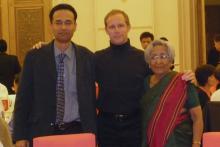Tony Cagle (PhD in Archaeology, 2001) fell into public health research by accident, having secured a position with King County Public Health in 1990 to support himself through the dissertation process. He ended up staying there until 2005—four years after obtaining his PhD in archaeology—and moved on to a few grant-funded positions over the next several years with various agencies. Most of these had a global health focus, notably a multisite cervical cancer-screening project in China and India with PATH, an international nonprofit global health organization. Since 2010, Tony has been working with the UW’s Department of Global Health in connection with the Coptic Hope Center for Infectious Diseases in Kenya.
Tony has also continued his archaeological research in Egypt, most recently teaching a field school at the Greco-Roman site of Karanis, and before that teaching field schools for Egyptian antiquities inspectors with the American Research Center in Egypt. Together with retired UW professor Rob Wenke, he is putting the finishing touches on the Kom el-Hisn (Egypt) monograph. In addition, between public health positions he has busied himself with Cultural Resource Management projects in Washington.
At first glance one might think that having an advanced archaeology degree would contribute very little to the business of conducting public health research. But on closer inspection…well, you’d be mostly right. With some exceptions, his training in archaeology offered good basic training in research, data analysis, and writing, which helped him to contribute to the research projects he has worked on. But public health and biomedical research have very different, and generally more stringent, data collection and analysis protocols than is usually the case in archaeology. Despite having a strong background in statistical analysis, Tony discovered that he had a very steep learning curve when it came to conducting rigorous epidemiological analyses. Plus in archaeology researchers are not usually trying to save living people but are studying dead ones.
Nevertheless, there are some areas of interaction wherein the archaeological practitioner of public health can garner expertise from both sides and use it to contribute in both areas. For one, having successfully navigated the intricacies of Egyptian Antiquities Service politics helped Tony in dealing with colleagues from similar bureaucratic contexts in developing countries. Learning how to work within the local political structures is something every anthropologist must learn in order to complete fieldwork successfully, be it excavating a site in Egypt or conducting ethnographic research in New Guinea. And, of course, the basic anthropological principles drilled into students early and often—that different groups of people think, feel, reason, and behave differently—is especially helpful when dealing with foreign populations and also subcultures within one’s own borders. And recently Tony has also been applying some public health concepts and research practices to the study of archaeology in the form of ancient health practices and problems.
1. Tony with Indian colleagues at the 24th International Papillomavirus Conference, Beijing, 2007.
2. Tony teaching a field school at the Greco-Roman site of Karanis. Photo by Jason Quinlan.
